|
A Brief History of Southerndown |
Return to main History page
Other History pages: St. Brides
Major | Southerndown |
Ogmore-by-Sea |
Marine | School
Dunraven House circa 1765
On the headland are the remains of an Iron Age hill fort (c500BC) that was the westernmost of several to be found at regular intervals along the coastline from Barry to Bridgend, as well as evidence of tumuli. The ancient name for Dunraven was Dyndryfan, meaning the fortress of the three rocks or triangular fortress. Scandinavian warriors dominated Europe and the North Atlantic between 800 and 1050AD and there is evidence that the Vikings settled in this area as some of the place names still used today testify, such as Caldey, Skokholm and Skomer Islands, Laleston, Sker and Swansea. Some corruption in spelling has taken place, as with Tusca, Tusker or Tuskar Rock which comes from the name of a Dane called Tuska. Southerndown is thought to be a corruption of South Down (and Norton similarly of North Down). In more modern times locations have been blurred or confused; for example, some early postcards (1900 to 1940s) detail Dunraven Bay and Castle as being in Ogmore-by-Sea (previously known as Sutton) probably for ease of identification owing to the relatively few dwellings present, changes to Parish boundaries and the position of the photographer taking the picture who was perhaps at the top of the cliffs between the villages.
There is a record of the Saxons burning the site in 1050.
Rhys ap Tewdwr is also noted as destroying a residence in 1080 when it
was the home of Iestyn ap Gwrgan, the last native prince of Glamorgan.
When William de Londres (the
first Norman to be granted the Lordship of Ogmore in 1093) returned from a visit
to Kidwelly, he learned that a steward had forced attackers of Ogmore Castle to
retreat. As a result of the gallant
fight he had put up, Arnold Botiler was granted a Knighthood in about 1128 and
given Dunraven. He is said to have
built a castle, and early English masonry has been discovered on the site.
The tenure of the Manor was three cups of wine, to be drunk whenever the
Lord of the Manor of Ogmore visited Dunraven.
Three golden cups
(which is retained in the name of the local pub) were included in the arms of Le Botiler
(or Boeteleur) and are the
family crest of the Butlers as they are also known.
Owen Glyndwr reportedly destroyed the castle
in the early 15th century.
By the 1540s, Dunraven was
described as a Manor Place owned by Walter Vaughan.
It had transferred to this family on the marriage of Ann, daughter of John and Jane
Butler. It was
sold in 1642 to the Wyndham family of Clearwell in Gloucestershire. In
1803 Mr. Thomas Wyndham made many alterations; his grandson Edwin Richard
Wyndham Quin (whose mother was Countess Caroline) undertook major works in 1858.
Further alterations were made in 1887, resulting in a magnificent 19th
century castellated mansion. Edwin
(Lord Adare) was a Member of Parliament. He became the third Earl of Dunraven in 1850.
Dunraven Castle
In 1886, the Duke and Duchess of Teck, with their daughter Princess May,
stayed at Dunraven. They visited the Red
House which stood near Newton Beach and dated back to the 1600s; the ruins were
demolished in the late 1940s.
The building was reputedly used as a smugglers den with a tunnel running under
Newton Church to the Jolly Sailor Inn at Newton and it is said contraband would
be off-loaded onto Tusker Rock then taken ashore.
In July, 1893, Princess May married the Duke of York; this couple were the future King George V and Queen Mary.
During the
First and
Second World Wars Dunraven Castle was used as a
Red Cross Hospital. Ivor Novello visited
in the 1940s during its time as a military hospital for wounded soldiers.
For a short while after its closure as a convalescent hospital it was a hotel/hostel
for the Workers Travel Association, before its final days when it was
demolished. In later years Dunraven Castle Laundry was converted to the Seamouth Café
and is
now used by Glamorgan Heritage Coast for offices and exhibitions.
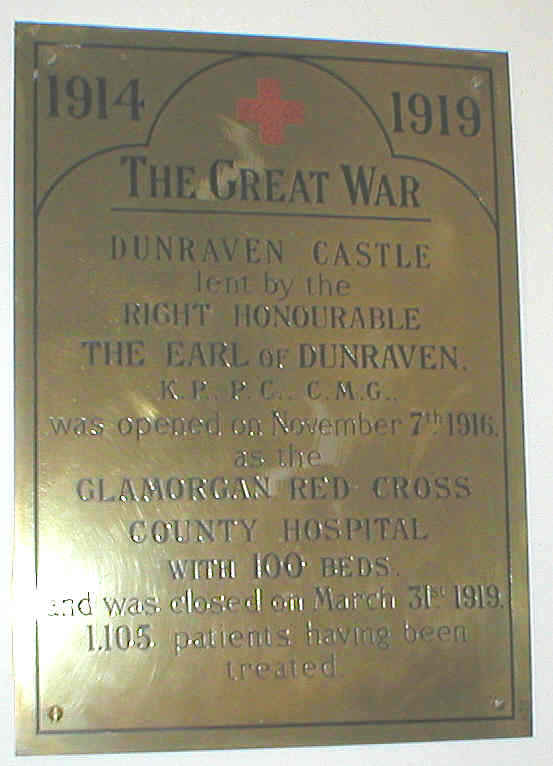
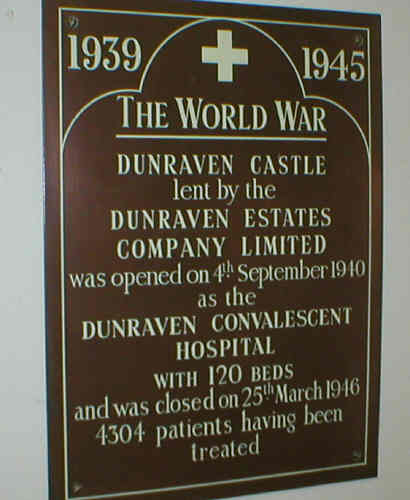
Left photo: Plaque commemorating the use of Dunraven Castle
as the Glamorgan Red Cross County Hospital during the Great War (1914-1918) and
beyond
Right photo: Plaque commemorating the use of Dunraven Castle as the Dunraven
Convalescent Hospital during the World War (1939-1945) and beyond
Nurses, staff and convalescents of Dunraven Castle in 1946, including Miss Betty Watkins (whose son, Mr. Paul D. E. Mitchell, supplied the picture for publication)
The rocky outcrop which trails into the sea at Dunraven Bay is shown on maps from around 1826/27 as Dunraven Point. Locally it is known as Trwyn-y-Witch (or Witches Point) and is named thus on more recent ordinance survey documents.
Frolic,
a wooden steam packet, went aground on Nash Sands in 1831.
A general was aboard and the loss of nearly 80 people including this high ranking military man led to the building of a pair of lighthouses on Nash Point in
1832.
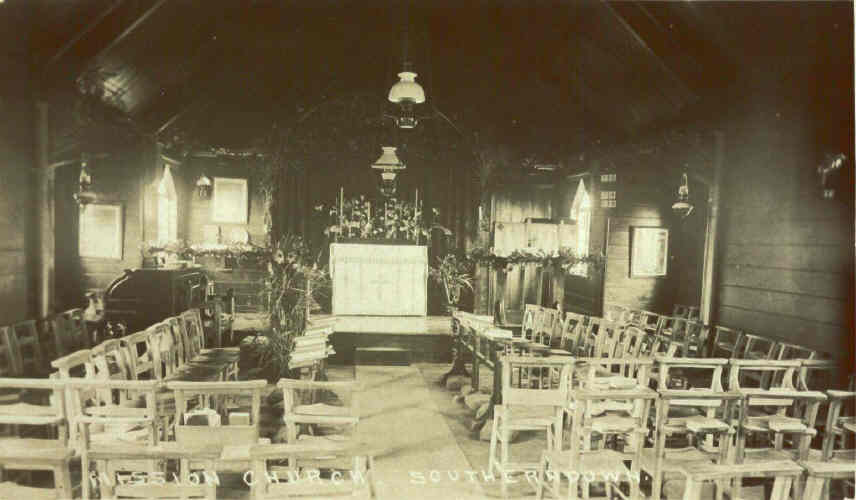
To commemorate the opening on 10th September,
1876, of Southerndown Reading Room, little books were signed by Miss Florence Lysaght of Newport,
Monmouthshire on 18th September, 1876 and presented to the children of the Parish.
These books had a picture cover and contained stories from the Bible.
The Reading Room, a corrugated iron building with drop tables secured to
the walls, was subsequently consecrated and became known as The Southerndown Mission Room. In 1967,
under the Glamorgan County road widening scheme, the Mission Room was demolished
together with a house known as Castle View.
A small modern church was then built in 1968 and called All Saints, Southerndown.
The Dunraven Hotel (sited almost opposite All Saints Church) was originally a low thatched building. This was demolished and rebuilt in 1890 to cater for a high class of visitor, running a horse brake service to and from Southerndown Road Station (now closed) at Castle-upon-Alun. On 5th June, 1948 the Wales Council for the Blind opened the premises as Southerndown Home for the Blind and Elderly, originally offering holidays for people with visual impairment. Southerndown Home was a registered charity with any profits used to improve and upgrade facilities. An active Comforts Committee raised funds by holding various events and ensured residents were entertained, for example by Bonfire Nights with fireworks and Christmas parties, etc., in addition to the many activities that were provided by management. The building was vacated in 2009 and the residents transferred to new premises in Bridgend.
In 1920 Southerndown became one of three Wards within the Parish of St. Brides Major. Parish Councils in Wales were replaced by Community Councils (or Town Councils) in 1974. Following changes in 1982 two Wards merged into St. Brides Major and Southerndown as part of St. Brides Major Community Council.
Dunraven Hotel circa 1909 (left) and circa 1940
Princess Margaret opened the Sunshine Home for Blind Babies at Southerndown in July, 1954. This building, which was once The Marine Hotel, overlooks the Bristol Channel and the Somerset coast. It closed down and was subsequently sold at the end of the 1970s. It was tastefully restored and became a private dwelling. The Vines (originally a stone house and rebuilt around 1913) was a Dame School then a bed & breakfast before conversion to residential property.
The site of Little West (near West Farm) is where a 19th century holiday home for gentry from Little St. Donat's stood. It became a hotel and restaurant, later a home for the elderly, then a residential property. In early 2006 the original building was demolished and a flats complex erected on the site.
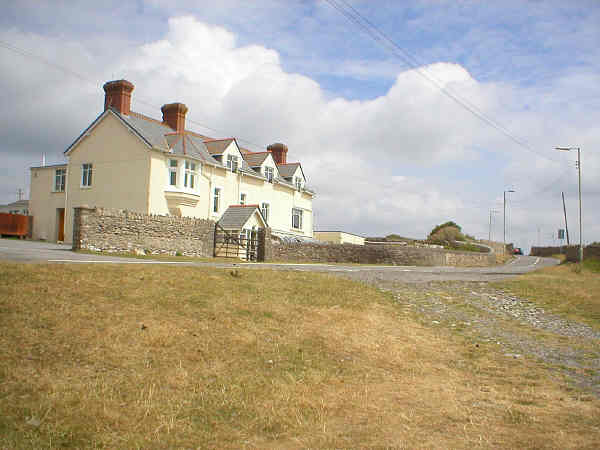
Little West in 2005
West Farm (situated between Southerndown and Ogmore-by-Sea) was once owned by the Powell family and became residential in the 1980s; for a few years after the turn of the 21st century there were tea rooms here. Around 2009 part of the building was converted to be able to show films then in 2011 alterations were made to provide two functions rooms known as The Barn.
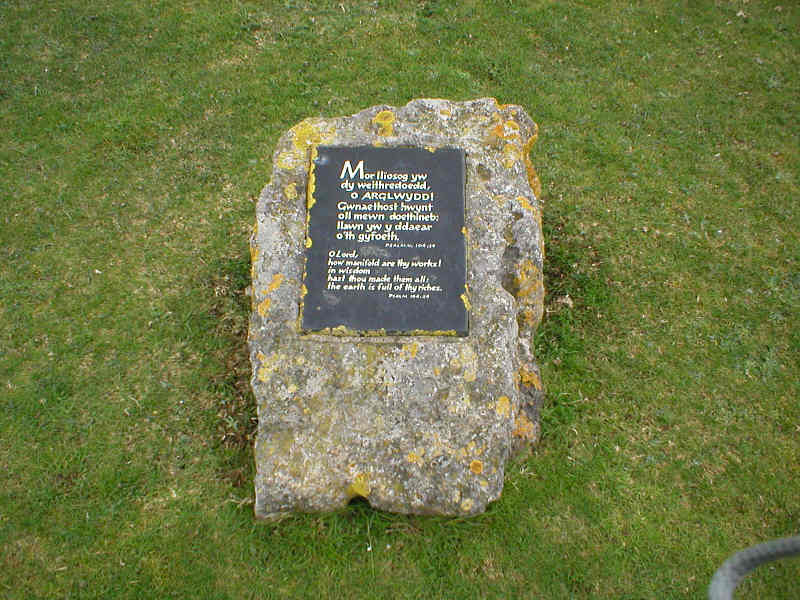
...and don't forget to see the Southerndown picture gallery!!
Other History pages: St.
Brides Major | Southerndown |
Ogmore-by-Sea |
Marine | School
Return to main History page